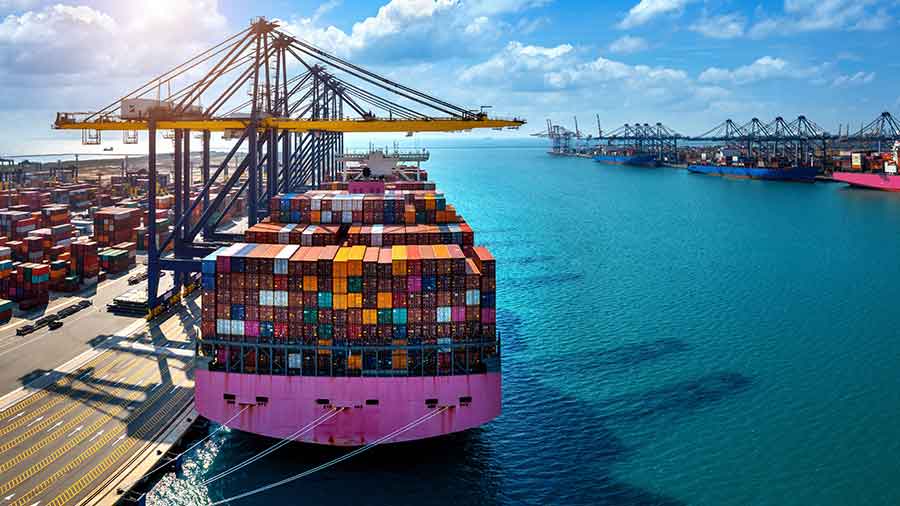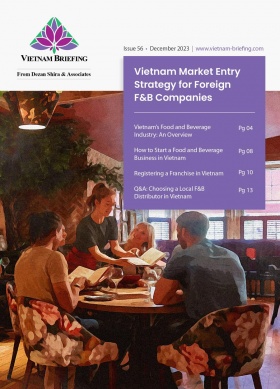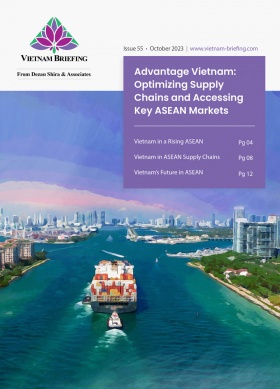Port Infrastructure in Vietnam: 3 Regional Hubs for Importers and Exporters
Port infrastructure across Vietnam’s regions varies significantly. Here, Vietnam Briefing compares the port infrastructure in three key economic regions, aiding investors in making well-informed decisions about where to locate their operations.
Vietnam’s rapid expansion of port infrastructure is playing a key role in meeting the accelerated demand of international trade, owing largely to its strategic positioning within the global supply chain and as a China+1 manufacturing hub. Boasting 3200 km of coastline and 320 ports, Vietnam has visibly augmented its logistical capabilities, enabling more efficient movement of goods. Container traffic in Vietnam witnessed exponential growth in the first half of 2024, highlighting the nation’s increasing significance in international trade and logistics networks.
The Vietnamese government has made substantial investments in technology and infrastructure, driven by ambitious goals to elevate port capacity to 400 million tons by 2030. It is, however, imperative for investors to recognize regional disparities in port infrastructure, as certain areas embrace advanced technologies like Smart Port and 3D digital twin models (e.g., Vung Tau Seaport). Such innovations enhance operational efficiency and sustainability, rendering Vietnam an increasingly appealing market for multinational transport and logistics firms.
With a strategic emphasis on infrastructure development and sustainability, Vietnam stands poised to fortify its position in the global economy while creating fresh avenues for investment and expansion. By embracing innovative port development strategies, Vietnam not only caters to corporate logistical requirements but also aligns with the global shift towards heightened environmental consciousness and technological integration. As this development unfolds, investors seeking port facilities for imports or exports must meticulously assess the regional discrepancies in port infrastructure quality before making any commitments. – Pritesh Samuel, Head of Business Intelligence, Dezan Shira & Associates
Vietnam’s ports competitiveness
In the last decade, Vietnam’s economic growth has led to a notable increase in freight traffic, emphasizing the importance of developing port infrastructure for businesses investing in the country.
While the rise in container traffic shows that Vietnam’s ports can adapt to higher demand, it also highlights the need for ongoing infrastructure investments to keep pace with growth and reduce logistics costs for companies. Despite recent progress, Vietnam still ranks 83rd in port service efficiency, according to the World Economic Forum (Open Dev VN).
Vietnam operates 44 ports, collectively equipped with a significantly expanded capacity capable of handling 700 million tons annually. This advancement is necessary for Vietnam’s goal of meeting growing global demand and improving the efficiency of its logistics network.
Three seaports in Vietnam are ranked among the top 50 globally in terms of cargo throughput, according to a 2022 report from Lloyd Maritime Company (UK). The ports are Saigon port (ranked 22nd), Hai Phong port (ranked 28th), and Cai Mep port (ranked 32nd).
In the below sections, we spotlight significant ports across different regions in the country and efforts underway to develop and integrate inland waterway routes.
Northern Vietnam
The North Key Economic Zone (NKEZ) includes many of Vietnam’s most dynamic manufacturing hubs, and covers Hanoi, Bac Ninh, Hung Yen, Vinh Phuc, Hai Duong, Hai Phong, and Quang Ninh provinces. Hosting diverse industries, including manufacturing, electronics, and logistics, NKEZ plays a pivotal role in Northern Vietnam’s economic landscape.
Hai Phong and Vung Ang are major ports for international container traffic in Northern Vietnam. The Haiphong International Container Terminal (HICT) established a deep-water port in Hai Phong in May 2018.
HICT can accommodate container ships as large as 14,000 TEUs, facilitating direct shipping to key markets like the United States and the European Union (EU). This not only enhances logistics efficiency but also reduces the need to route product shipments through other regional maritime hubs like Hong Kong and Singapore.
HICT’s favorable location serves as a pivotal connecting point for inland waterways and coastal roads to Quang Ninh province and the midland provinces of Northern Vietnam. Linked to key economic regions via the Tan Vu Lach Huyen bridge and Haiphong – Hanoi expressway, its proximity to China positions it favorably for companies utilizing Northern Vietnam as a China+1 base.
Haiphong holds significant importance in Vietnam’s socio-economic development, particularly in the Northern region. It serves as a crucial port city, industrial center, and the largest seaport in Northern Vietnam, while also functioning as an economic, cultural, medical, educational, scientific, commercial, and technological hub in the Northern coastal region. Recent development momentum in Haiphong is attributed to comprehensive infrastructure upgrades, numerous tax incentives, and robust governmental support.
In 2024, as part of the Dutch Trade mission to Vietnam, APM Terminals and Hateco Haiphong International Container Terminal (HHIT), a subsidiary of Hateco Group, signed a memorandum of understanding (MOU) to deepen their cooperation on terminal development in Haiphong.
Prior to this, APM Terminals had announced a strategic partnership with the Hateco Group in 2023 for a project to develop two new deep-water berths at Lach Huyen port in Haiphong City. Expected to commence operations in the first quarter of 2025, this project aims to attract mega vessel services to Haiphong and significantly reduce import and export costs for Northern Vietnam. According to its press release, APM Terminals will contribute its expertise in safety, port automation, artificial intelligence, and decarbonization to the project undertaking.
Central Vietnam
The primary ports in Central Vietnam are Quy Nhon and Da Nang, with the latter being a deep-water port. The region also hosts nine minor ports.
Da Nang Port, situated in Da Nang Bay spanning an area of 100km², features a convenient transportation network and serves as a pivotal gateway in the logistics service chain of Central Vietnam. It is designated as the terminus of the East–West Economic Corridor, connecting Myanmar, Thailand, Laos, and Vietnam, and serves as the main gateway to the East Sea for the entire region.
Recent data reflects Da Nang Port’s profile as an important maritime hub in the region, with over 1,700 ships traversing its waters and handling a total of 12 million tons of cargo. Moreover, the port manages approximately 679,999 TEUs, showcasing its capacity in container handling.
Quy Nhon Port serves as another major port for the region. It is located in Binh Dinh province and provides easy accessibility for neighboring countries like Laos and Cambodia. The port also boasts 10 maritime routes connecting to international ports like Singapore, Thailand, and Japan.
In 2023, Quy Nhon Port handled a substantial volume of cargo, with a total throughput of 9,579,310 tons.
Southern Vietnam
Saigon Port, a network of ports in Ho Chi Minh City—Vietnam’s commercial hub—is one of six primary seaports in the country and the sole facility capable of handling post-Panamax ships. Known for its high productivity and cargo-handling capacity of approximately 10 million tons annually, Saigon Port plays a central role in the region’s economic landscape.
Additionally, the Cai Mep-Thi Via Port (Cai Mep), situated approximately 80km south of Ho Chi Minh City, is a deep-water port predominantly serving Dong Nai and Binh Duong provinces, which are also major production centers in Southern Vietnam. Cai Mep is a preferred choice for shipping routes to the US and EU markets.
However, Cai Mep currently operates at only about 30 percent of its capacity due to competition from other regional ports like Cat Lai. Although not a deep-water port, Cat Lai is often considered an alternative seaport for routes to Asia due to its strategic location near major industrial hubs, albeit at higher transshipment costs.
Since 2007, APM Terminals has played an active role in the joint venture Cai Mep International Terminal (CMIT), strategically positioned to support Ho Chi Minh City. CMIT is among the select terminals in Southeast Asia capable of accommodating the world’s largest container vessels.
Industry challenges
The foremost challenge confronting Vietnam’s largest ports is the predominance of smaller ports and vessels, which handle approximately 80 percent of container imports and exports in the country. Some ports grapple with overwhelming shipment volumes, resulting in congestion and significant delays.
As mentioned earlier, Cai Mep port operates at only 30 percent of its capacity due to competition from regional ports such as Cat Lai due to its proximity to industrial hubs and metropolitan areas. Yet, Cat Lai faces operational inefficiencies. With over 22,000 vehicles passing through daily, congestion and delays are commonplace, exacerbated by inadequate rail and road connectivity.
Efforts are underway to alleviate congestion at Cat Lai Port, including expediting infrastructure projects and enhancing traffic control systems to improve flow and eliminate bottlenecks. However, challenges persist in the development of road and rail infrastructure around ports, leading to increased costs and logistical complexities.
Customs procedures pose another hurdle, with businesses experiencing delays and increased container idle times at ports. Streamlining customs procedures is imperative to ensure Vietnam remains competitive compared to neighboring rivals like Singapore, Thailand, and Malaysia.
As part of the Master Plan for Seaport System Development (2021–2030), Vietnam aims to enhance port capacity to meet burgeoning demand for international trade. In 2021, it was hoped that by 2023, cargo clearance would increase from 1.14 billion tons to 1.42 billion tons.
The government is concentrating efforts on developing both existing and new deep-water ports, with significant initiatives underway in key areas, such as Hai Phong and Cai Mep, to accommodate greater international traffic and bolster Vietnam’s participation in global shipping routes.
Developing inland waterways
While road transport is a primary mode for freight transportation in Vietnam, freight traffic via inland waterways surged to 31.6 billion metric ton-kilometers in 2022. In November 2021, the Ministry of Transport estimated that VND157 trillion (US$6.9 billion) would be required for inland waterway projects over the next decade. A detailed master plan for inland waterway infrastructure development spanning 2021-2030, with a vision to 2050, was subsequently released by the transport ministry.
The master plan encompasses various projects aimed at addressing traffic bottlenecks and enhancing the air draft of bridges along key waterway routes, such as Duong Bridge in the Quang Ninh – Haiphong – Viet Tri section in the north, the World Bank-funded Day-Ninh Co canal channel in the north, and the Cho Gao channel upgrade phase 2 in the Mekong Delta.
Moreover, the government is committed to advancing the development of the southern waterway logistics corridor and investing in inland ports and logistics centers. Under the master plan, between 2026 and 2030, investments will commence in upgrading primary inland waterway routes nationwide, increasing the air draft of railway bridges crossing national inland waterways, and further expanding inland waterway ports.
The state budget will allocate VND29 trillion ($1.27 billion) for constructing inland waterway routes, while an additional VND128.6 trillion (US$5.64 billion) will be mobilized from private sources for port investments. The overarching objective is to ensure that inland waterway corridors can accommodate the projected transportation demand, estimated at 715 million tons of goods and 397 million passengers by 2030, with expectations of further growth in the future.
To facilitate river transport, the government has provided official development assistance and concessional international loans. This financial support aims to bolster the development of inland yards and logistics hubs, crucial components in integrating Vietnam’s extensive canal network with alternative transportation modes like trucking.
Outlook
With large-scale port development projects underway in both the northern and southern regions, foreign investors from Japan and the Netherlands have expressed interest in spearheading port projects in the country. The Vietnamese government is actively promoting the development of ports through public-private partnerships, aligning with its masterplan objectives.
Given that sea-based transport dominates international trade, expanding the number of value-added ports and enhancing the capacity of existing ones will be crucial for both the government and manufacturers. This initiative aims to accelerate transport processes and mitigate costs.
Efficient development of Vietnam’s ports holds the potential to fuel the country’s growth over the next decade. Businesses intending to manufacture and trade in Vietnam should carefully evaluate the regional disparities in port infrastructure and select a location that best aligns with their operational needs.
In 2022, Vietnam’s total sea cargo throughput amounted to approximately 368.68 million metric tons. Among the regions, Southern Vietnam recorded the highest sea cargo throughput, totaling 219.7 million metric tons, followed by 98.3 million metric tons in Northern Vietnam and 50.6 million metric tons in Central Vietnam.
This article was originally published in May 2018. It was last updated May 15, 2024.
About Us
Vietnam Briefing is published by Asia Briefing, a subsidiary of Dezan Shira & Associates. We produce material for foreign investors throughout Asia, including ASEAN, China, and India. For editorial matters, contact us here and for a complimentary subscription to our products, please click here. For assistance with investments into Vietnam, please contact us at vietnam@dezshira.com or visit us at www.dezshira.com.
Dezan Shira & Associates assists foreign investors throughout Asia from offices across the world, including in Hanoi, Ho Chi Minh City, and Da Nang. We also maintain offices or have alliance partners assisting foreign investors in China, Hong Kong SAR, Dubai (UAE), Indonesia, Singapore, Philippines, Malaysia, Thailand, Bangladesh, Italy, Germany, the United States, and Australia.
- Previous Article Hanoi Attracts Over US$1 Billion in FDI in First Four Months of 2024
- Next Article ¿Es Vietnam una economía de mercado? EE.UU. estudia mejorar su estatus
































